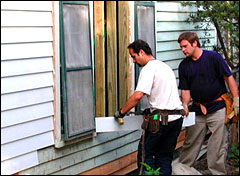Dear Umbra,
I have been a homeowner for five years and gradually I am upgrading the 25-year-old house to be more green. I have finished replacing the single-pane windows with Energy Star-rated double-pane windows. Now I am turning my attention to the siding, since the roof is still in good shape. I have wood siding and there is a bit of rot (not to mention my puppy thought the house was a chew toy). I am trying to decide what is best both from an environmental standpoint as well as my budget. I know there are several siding options out there, but I don’t know how environmentally friendly they are. Also I wonder if it would be better just to replace the damaged boards and repaint.
Donna
Bogart, Ga.
Dearest Donna,
A dog undaunted by the enormity of the undertaken task. Maybe you should just go with your dog’s recommendation for tastiest siding: fiber-cement has a sort of musty taste, while painted wood has a classic earthy crunch. Vinyl cuts the roof of the mouth and aluminum is to be avoided due to laceration potential.
I do think you’re right; it may be best just to replace the damaged boards and repaint (“a bit of rot” doesn’t sound like very much). However, you need a knowledgeable person to come look at your house, and I’m booked on siding viewing through November ’09.
You could start getting bids on replacement from siding companies and end up with several evaluations that way. The knowledgeable person will evaluate the type of wood, the age of the wood, the condition of the sheathing under the siding, and the extent of the damage. You should ask him/her how long the unchewed siding should be expected to survive under normal maintenance conditions.
If we look at the whole environmental picture, and there is nothing wrong with the sheathing under the siding — you have no mold, leaks, or condensation — this will lead us toward minor mending as the best environmental choice. Replacing any of the siding leads to energy consumption in the form of disposal of old siding and manufacture/shipping/installation of the new, so limiting the replacement as much as possible is a good way to go. Wood siding in decent shape should be easily spot repairable, a choice leading to least waste and least new wood.
As you may know, the best types of wood to purchase are reclaimed woods or FSC-certified wood. Reclaimed wood — which you should be able to find online if you can’t find a local source by phone book or word of mouth — obviously requires no new trees, and the Forest Stewardship Council is recognized as the most thorough certifier of sustainably grown timber. The certification is widespread and may be available where you live. You need to make sure that you are buying decent, sturdy, siding-appropriate wood, and I’m not sure which type of wood is best for that purpose in Georgia homes. In Seattle, old-growth cedar is the wood siding of choice: local, water-resistant, and long-lasting.
Other than wood, the siding choices that may confront you with a full-on replacement are fiber cement, aluminum or steel, and vinyl. Vinyl siding is cheap, ugly, and environmentally toxic. In my circle of green folks, fiber-cement boards have been making inroads (the first I heard of were HardiPlank, but they come under many names). Fiber cement is Portland cement (that is, basic cement) mixed with natural fibers such as wood. Fiber cement is cheaper than wood, can be made to look wood-ish, holds paint well, won’t rot or be eaten by termites, and is supposed to last 50 years. The long life of fiber cement is held out as compensation for the energy-intensive manufacture of Portland cement. Aluminum and steel siding are often made of recycled metal, so the high manufacturing input of virgin metal is not usually a worry. But steel can rust, and aluminum can get dented (usually experts say “by hail,” but in your case it’s “by dog”). Whether aluminum is appropriate to your home, only you and your local expert can tell. I aesthetically prefer wood or fiber cement.
If you do replace all the siding, one aspect to consider in weighing the benefits of these various materials is their actual weight and how far they will need to be shipped to get to you (or the siding store). I think aluminum and steel are likely the heaviest, so keep that under consideration. And buy local if you can.
Claddingly,
Umbra


